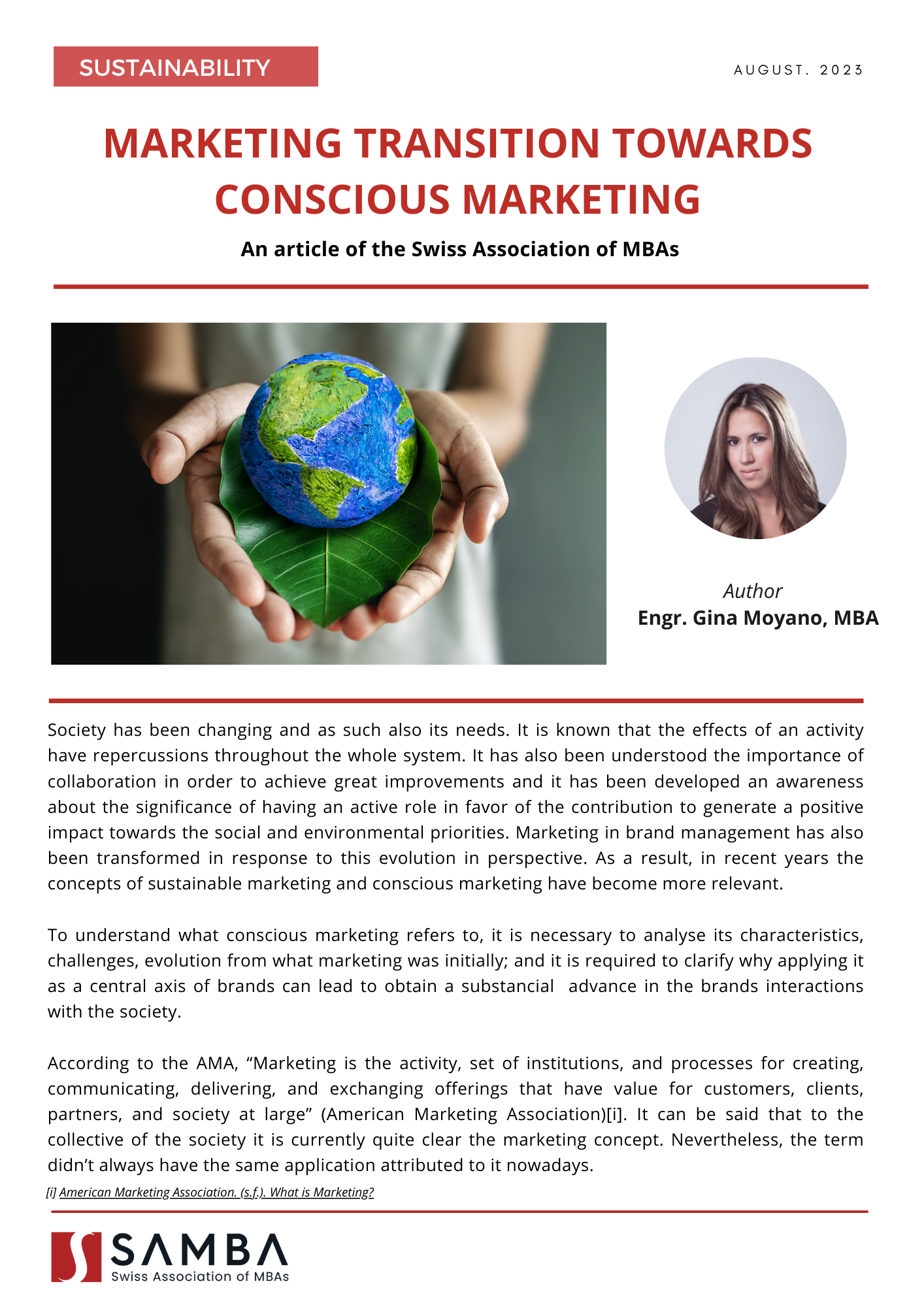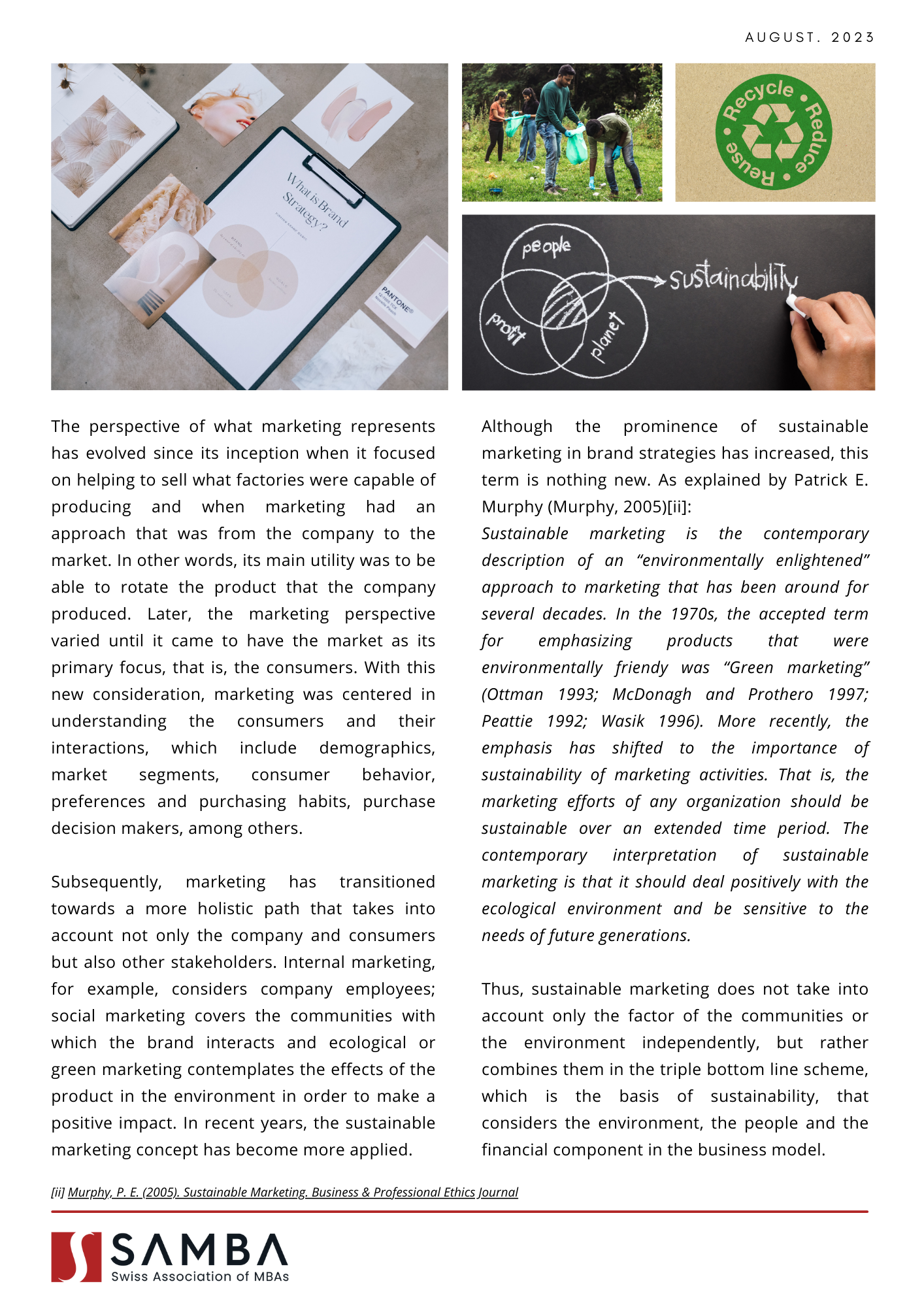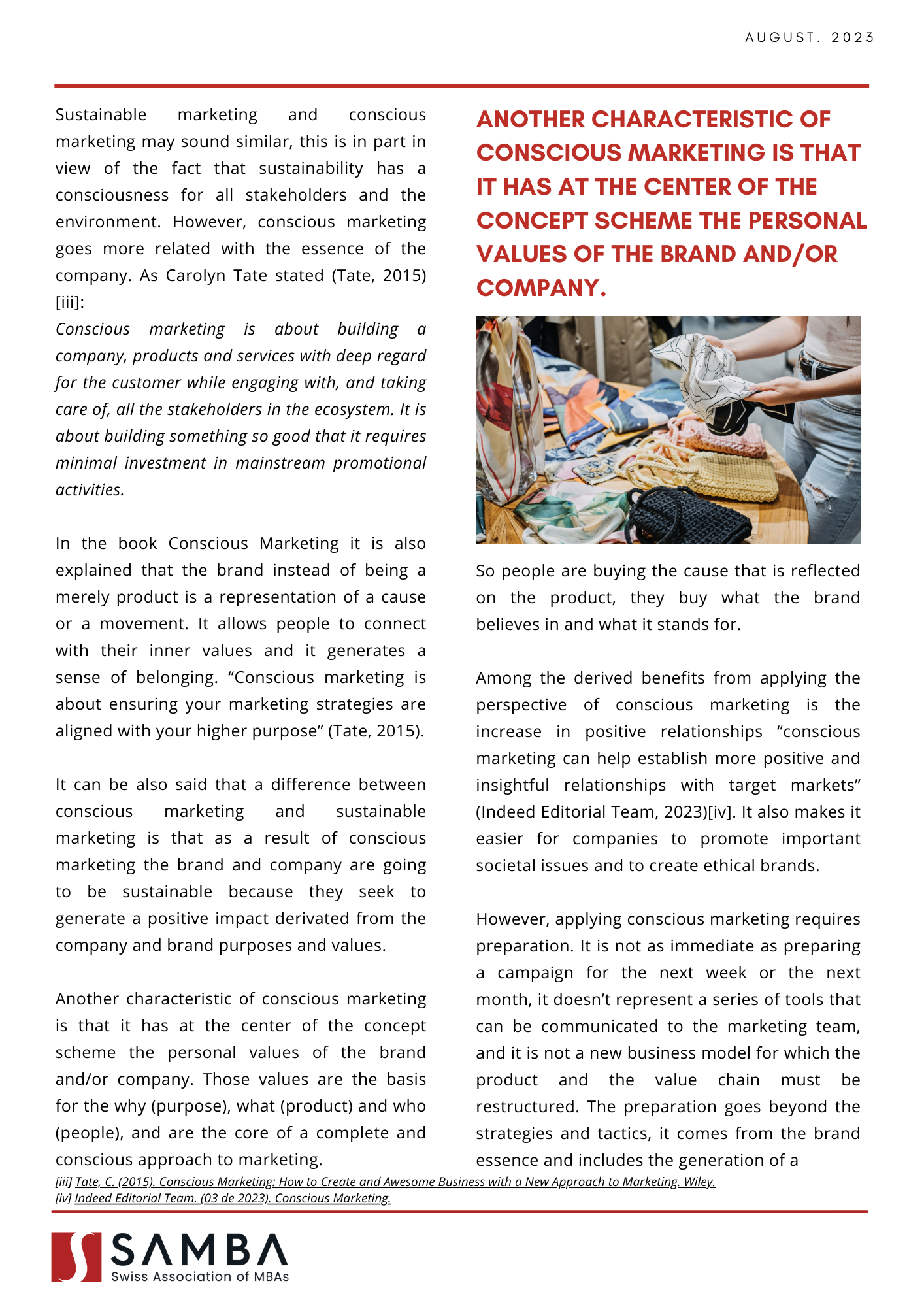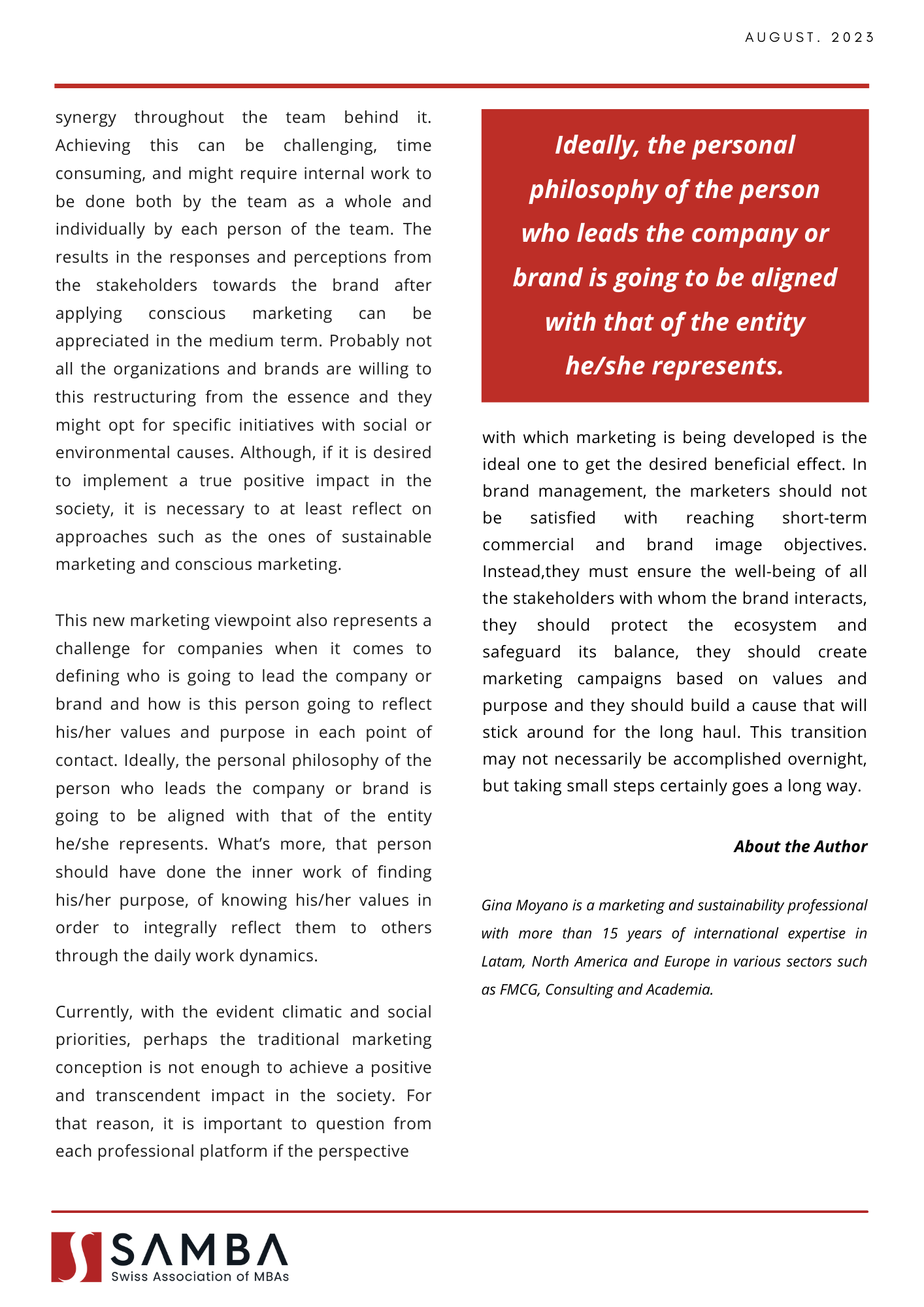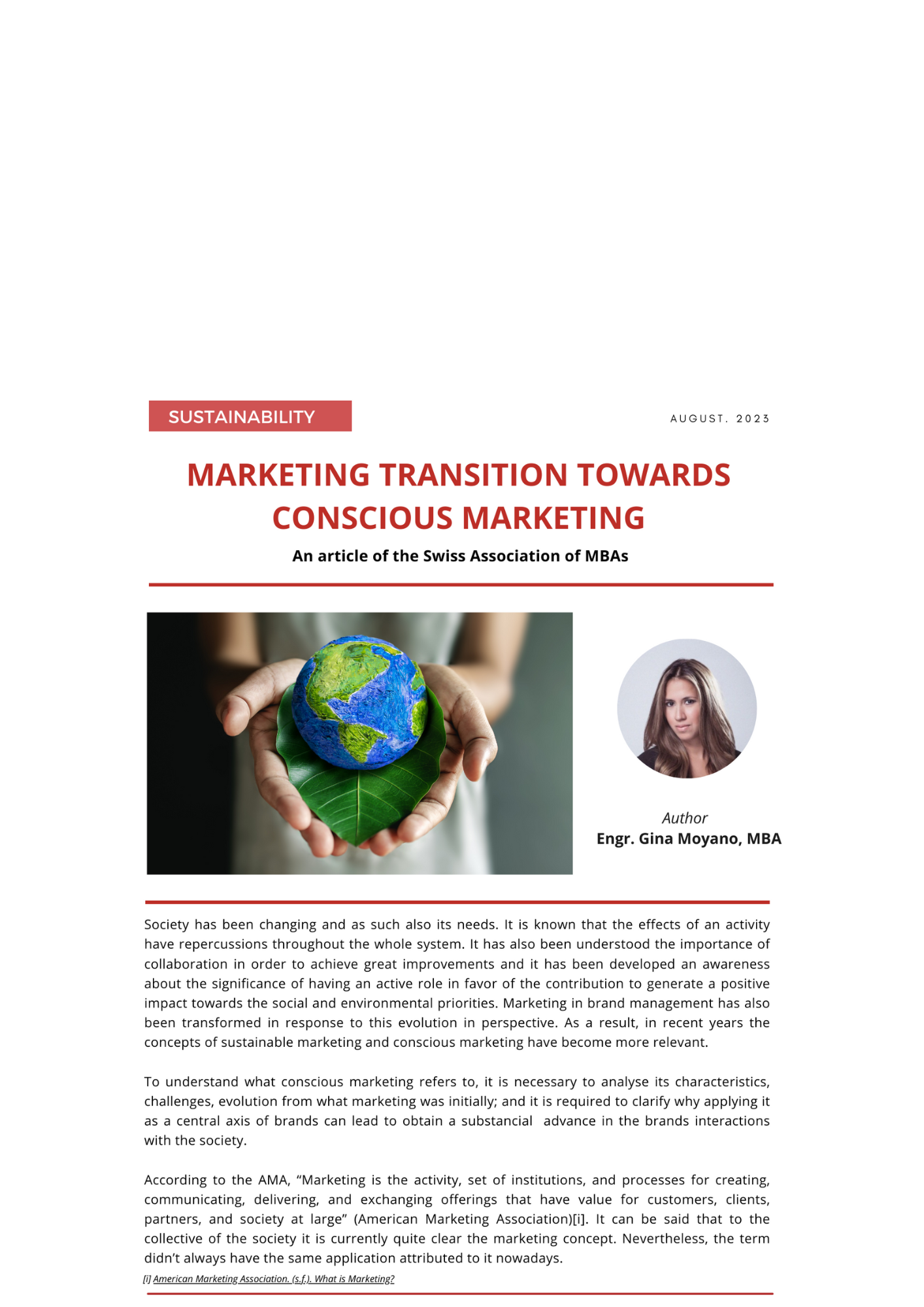
Society
has been changing and as such also its needs. It is known that the effects of
an activity have repercussions throughout the whole system. It has also been
understood the importance of collaboration in order to achieve great
improvements and it has been developed an awareness about the significance of
having an active role in favor of the contribution to generate a positive
impact towards the social and environmental priorities. Marketing in brand
management has also been transformed in response to this evolution in
perspective. As a result, in recent years the concepts of sustainable marketing
and conscious marketing have become more relevant.
To
understand what conscious marketing refers to, it is necessary to analyse its
characteristics, challenges, evolution from what marketing was initially; and
it is required to clarify why applying it as a central axis of brands can lead
to obtain a substantial advance in the brands
interactions with the society.
Acdording to the AMA, “Marketing is
the activity, set of institutions, and processes for creating, communicating,
delivering, and exchanging offerings that have value for customers, clients, partners,
and society at large”
The
perspective of what marketing represents has evolved since its inception when
it focused on helping to sell what factories were capable of producing and when
marketing had an approach that was from the company to the market. In other
words, its main utility was to be able to rotate the product that the company
produced. Later, the marketing perspective varied until it came to have the
market as its primary focus, that is, the consumers. With this new consideration,
marketing was centered in understanding the consumers and their interactions,
which include demographics, market segments, consumer behavior, preferences and
purchasing habits, purchase decision makers, among others.
Subsequently,
marketing has transitioned towards a more holistic path that takes into account
not only the company and consumers but also other stakeholders. Internal
marketing, for example, considers company employees; social marketing covers
the communities with which the brand interacts and ecological or green
marketing contemplates the effects of the product in the environment in order
to make a positive impact. In recent years, the sustainable marketing concept
has become more applied. Although the prominence of sustainable marketing in
brand strategies has increased, this term is nothing new. As explained by Patrick
E. Murphy
Sustainable marketing is the contemporary description of
an “environmentally enlightened” approach to marketing that has been
around for several decades. In the 1970s, the accepted term for emphasizing
products that were environmentally friendy was “Green marketing” (Ottman 1993;
McDonagh and Prothero 1997; Peattie 1992; Wasik 1996). More recently, the
emphasis has shifted to the importance of
sustainability of marketing activities. That is, the marketing efforts
of any organization should be
sustainable over an extended time period. The contemporary interpretation of
sustainable marketing is that it should deal positively with the ecological
environment and be sensitive to the needs of future generations.
Thus,
sustainable marketing does not take into account only the factor of the
communities or the environment independently, but rather combines them in the
triple bottom line scheme, which is the basis of sustainability, that considers
the environment, the people and the financial component in the business model.
Sustainable
marketing and conscious marketing may sound similar, this is in part in view of
the fact that sustainability has a consciousness for all stakeholders and the
environment. However, conscious marketing goes more related with the essence of
the company. As Carolyn Tate stated
Conscious marketing is about building a company, products
and services with deep regard for the customer while engaging with, and taking
care of, all the stakeholders in the ecosystem. It is about building something
so good that it requires minimal
investment in mainstream promotional activities.
In the
book Conscious Marketing it is also explained that the brand instead of being a merely product is a representation of a cause or a
movement. It allows people to connect with their inner values and it generates
a sense of belonging. “Conscious
marketing is about ensuring your marketing strategies are aligned with your
higher purpose”
It can be
also said that a difference between conscious marketing and sustainable
marketing is that as a result of conscious marketing the brand and company are
going to be sustainable because they seek to generate a positive impact
derivated from the company and brand purposes and values.
Another
characteristic of conscious marketing is that it has at the center of the
concept scheme the personal values of the brand and/or company. Those values
are the basis for the why (purpose), what (product) and who (people), and are
the core of a complete and conscious approach to marketing. So people are
buying the cause that is reflected on the product, they buy what the brand
believes in and what it stands for.
Among the
derived benefits from applying the perspective of conscious marketing is the
increase in positive relationships “conscious marketing can help establish more
positive and insightful relationships with target markets”
However,
applying conscious marketing requires preparation. It is not as immediate as
preparing a campaign for the next week or the next month, it doesn’t
represent a series of tools that can be communicated to the
marketing team, and it is not a new business model for which the product and
the value chain must be restructured. The preparation goes beyond the
strategies and tactics, it comes from the brand essence and includes the
generation of a synergy throughout the team behind it. Achieving this can be
challenging, time consuming, and might require internal work to be done both by
the team as a whole and individually by each person of the team. The results in
the responses and perceptions from the stakeholders towards the brand after applying
conscious marketing can be appreciated in the medium term. Probably not all the
organizations and brands are willing to this restructuring from the essence and
they might opt for specific initiatives with social or environmental causes. Although,
if it is desired to implement a true positive impact in the society, it is
necessary to at least reflect on approaches such as the ones of sustainable
marketing and conscious marketing.
This new
marketing viewpoint also represents a challenge for companies when it comes to
defining who is going to lead the company or brand and how is this person going
to reflect his/her values and purpose in each point of contact. Ideally,
the personal philosophy of the person who leads the company or brand is going to be aligned with that of the entity
he/she represents. What’s more, that person should have done the inner work of
finding his/her purpose, of knowing his/her values in order to integrally
reflect them to others through the daily work dynamics.
Currently, with the evident climatic and social priorities, perhaps the traditional marketing conception is not enough to achieve a positive and transcendent impact in the society. For that reason, it is important to question from each professional platform if the perspective with which marketing is being developed is the ideal one to get the desired beneficial effect. In brand management, the marketers should not be satisfied with reaching short-term commercial and brand image objectives. Instead, they must ensure the well-being of all the stakeholders with whom the brand interacts, they should protect the ecosystem and safeguard its balance, they should create marketing campaigns based on values and purpose and they should build a cause that will stick around for the long haul. This transition may not necessarily be accomplished overnight, but taking small steps certainly goes a long way.
References
[i] American Marketing Association. (s.f.). What is Marketing?
[ii] Murphy, P. E. (2005). Sustainable Marketing. Business & Professional Ethics Journal
[iv] Indeed Editorial Team. (03 de 2023). Conscious Marketing.

